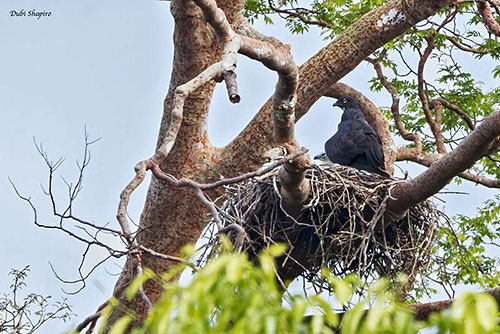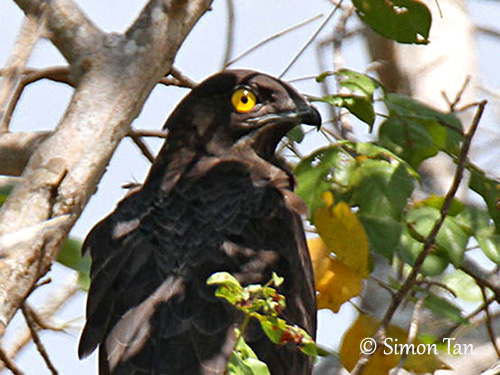
Fr: Alcin des chauves-souris – Milan des chauves-souris
Ang: Bat Hawk
All: Fledermausadler
Esp: Milano Murcielaguero
Ita: Nibbio dei pipistrelli
Nd: Vleermuiswouw
Sd: fladdermusvråk
Photographers:
Dubi Shapiro
Dubi Shapiro Photo Galleries
Simon Tan
PBase Bird galleries
Text by Nicole Bouglouan
Sources:
HANDBOOK OF THE BIRDS OF THE WORLD Vol 2 by Josep del Hoyo-Andrew Elliot-Jordi Sargatal - Lynx Edicions - ISBN: 8487334156
BIRDS OF AFRICA SOUTH OF THE SAHARA by Ian Sinclair and Peter Ryan - Princeton University Press Princeton and Oxford - ISBN: 0691118159
BIRDS OF PREY OF AFRICA AND ITS ISLANDS by Alan and Meg Kemp - Struik Publishers - ISBN: 1770073698
ROBERTS BIRDS OF SOUTH AFRICA by G. R. Mc Lachlan and R. Liversidge – The Trustees of the John Voelcker Bird Book Fund – ISBN: 0620031182
BIRDS OF THE GAMBIA AND SENEGAL by Clive Barlow and Tim Wacher – Helm Field guides – ISBN: 0713675497
PREY OF BAT HAWKS AND AVAILABILITY OF BATS
The Peregrine Fund – World Centre for Birds of Prey
Global Raptor Information Network - Working to Conserve Birds of Prey in nature
Wikipedia, the free encyclopaedia
Bat Hawk
Macheiramphus alcinus
Accipitriformes Order – Accipitridae Family
INTRODUCTION:
The Bat Hawk is found in sub-Saharan Africa and Madagascar and S Asia to New Guinea. It frequents several types of habitats depending on the range. In Africa, it is usually seen in open areas in moist forest edges habitats, but it also occurs near human habitations and in tree plantations. In S Asia, it frequents mature and disturbed forests with some remains of tall vegetation. In New Guinea, it is found in cleared or disturbed forest and also in gallery forest along river or wetland.
This raptor in mainly a lowland species, although it reaches high plateaus in South Africa.
The Bat Hawk feeds primarily on bats (as its name suggests), but insects and birds (swifts and swallows) are also part of the diet. The prey are caught with the feet while flying at high speed.
Like numerous birds of prey, the Bat Hawk nests in a large stick nest built high up in tree by the pair. Both parents feed the single young.
The population of the Bat Hawk is currently suspected to be stable, and the species is not globally threatened for the moment.
DESCRIPTION OF THE BIRD:
Biometrics:
Length: 41-51 cm
Wingspan: 95-120 cm
Weight: 600-650 g
The Bat Hawk adult male is a dark raptor with owl-like eyes and the wings of a falcon.
The upperparts are blackish-brown. Both flight-feathers and rectrices show narrow, pale grey bars.
On the underparts, the throat is white with black streaks on the centre. The plumage is rufous-brown with some white on belly and flanks. But these features are very variable.
The head is black. There are white “eye” spots on the nape.
The black, hooked bill is relatively small but the gape is wide. Cere and gape are pale blue-grey.
The eyes are yellow, with a white eyebrow contrasting with the blackish plumage. The bare legs and the long, slender toes are pale blue-grey. The long middle toe assists during the capture of the fast-flying prey.

The female has similar plumage, but she is up to 6% larger than male.
The juvenile resembles adult, but there is more white on the underparts, and especially on throat, breast and belly. There is only a dark breast band. The flight-feathers are finely barred pale grey, whereas the tail may appear spotted.
SUBSPECIES AND RANGE:
The Bat Hawk has three subspecies.
M.a. alcinus (described above) is found in S Myanmar, W Thailand, Malay Peninsula, Sumatra, Borneo and possibly NC Sulawesi.
M.a. papuanus occurs in lowland and lower montane regions of S New Guinea.
This one has smaller crest than nominate race. There is more white on belly and a white nuchal collar.
M.a. anderssoni (displayed) occurs in Senegambia, E to Somalia and S to Namibia, and N South Africa. There are some records from Madagascar in far NE.
This race is the smallest. The flight-feathers show indistinct bars and the white areas on the underparts are very variable.
HABITAT:
The Bat Hawk can be found in dense tropical forest, but also in deciduous and evergreen forests. This raptor can be seen in woodlands, but also in grasslands and savanna. It is resident in bushes and plains in semi-arid areas. It hunts in wetlands and open areas, and roosts in dense foliage during the day.
The species is visible from sea-level to 1,000 metres in New Guinea, up to 2,000 metres on Mt Kilimanjaro in Tanzania, and up to 2,150 metres in Malawi.
CALLS AND SONGS: SOUNDS BY XENO-CANTO
The Bat Hawk is generally silent away from the nest-site where it gives weak, high-pitched kite-like whistles and falcon-like “kek-kek-kek”. We can also hear a shrill “kwik-kwik-kwik-kwik-kiwk” and a mellow “woot-woot-woot”.
The New Guinea race “M.a. papuanus” is more vocal and gives a typical hawk-like “kee-kee-kee-kee-kee” and a series of 12-13 high-pitched but weak notes. A repeated, short “kleEK” can be heard near the nest.
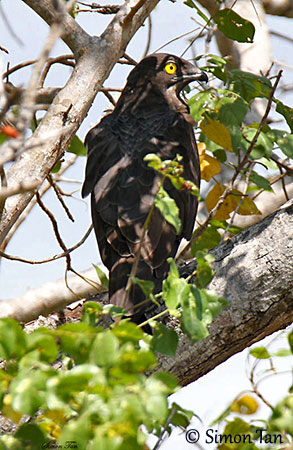
BEHAVIOUR IN THE WILD:
The Bat Hawk hunts primarily bats, but it also catches small birds such as swallows, swifts and nightjars, and insects.
It hunts on the wing, chasing the prey at high speeds, and almost 50% of the hunts are successful.
The bats leaving their roost are captured at dusk. The Bat Hawk feeds on the wing and the prey is swallowed whole, thanks to the large gape of this species. However, the prey are weighing only about 30 grams.
The Bat Hawk differs from the Bat Falcon from Central and South America, by its feeding behaviour. The Bat hawk swallows the bat whole and very quickly, about six seconds for the prey to reach the stomach. The Bat Falcon returns to a perch to eat the prey in pieces, not whole. But both species catch the prey with the feet.
The Bat Hawk is crepuscular. During most of the day, it remains perched in dense tree foliage and emerges at dusk. It often perches near a cave/bat dwelling, waiting for the dusk emergence. It is also active on moonlight nights and at dawn.
It may capture and eat up to 10-11 prey items in about 18-20 minutes, during the short window of time at dusk when the bats emerge from their roosts.
The Bat Hawk performs courtship displays at the beginning of the breeding season, involving many aerial displays and stunts. Acrobatic manoeuvres such as rolling and tumbling are usual, as well as talon-grappling. These aerial displays are spectacular.
The large stick nest is built in tall tree, often in outer fork to facilitate the landing. The nest can be reused year after year. The male provides food to the female which feeds the chick. Both adults share the nesting duties.
The Bat Hawk is generally resident in tropics, but in Subtropical South Africa, it may be recorded far from the usual habitat. It is a visitor in parts of NE Africa. There is one record of breeding in Madagascar in far NE.
The Bat Hawk has long wings and when in flight, it has falcon-like silhouette. While hunting, the flight is fast and powerful, otherwise languid and kite-like. The flight of this raptor is very silent due to the jagged trailing edge of the secondary flight-feathers.
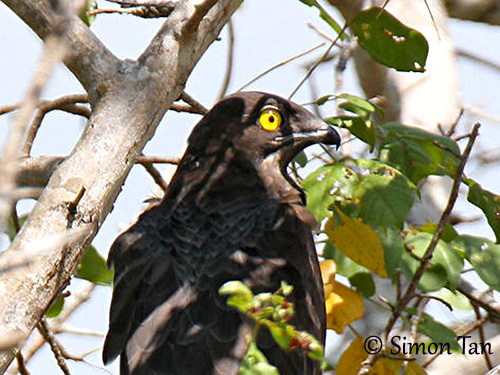
REPRODUCTION OF THIS SPECIES:
The Bat Hawk is monogamous with long-term pair bond. It is territorial and solitary nester.
The laying period varies in Africa depending on the range, from October/November in Senegambia, April-August and October in E Africa, and August-May in South Africa. In Malaysia and Sumatra, the eggs are laid from April to September.
This species builds a large stick nest high up in tree fork, often Eucalyptus tree. It is lined inside with fine twigs and green leaves. Both adults build the large structure but the female does more than the male. The twigs are broken off dead branches while the bird is flying. The nest is usually reused year after year.
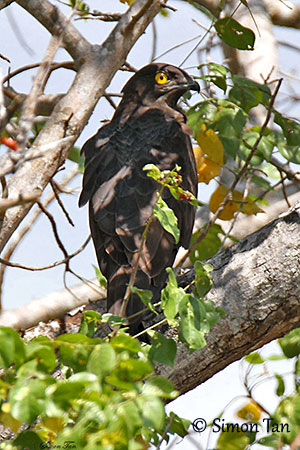
The female lays a single pale bluish egg with some darker markings at the larger end. She incubates during 48-53 days, sometimes helped by the male. At hatching, the chick has white down. The female feeds it with the food provided by the male.
The young stays in the nest about 67 days before to be ready to fly. During this period, it is fed by both parents. The adults may hunt during the day during the nesting period, in order to regularly feed the chick.
A replacement clutch is done 68-70 days later if the first breeding attempt fails.
PROTECTION / THREATS / STATUS:
The Bat Hawk is affected by woodland destruction in South Africa, because the local bat population depends on this habitat. It is also persecuted by locals, although it has never been observed killing chickens.
In addition, the Bat Hawk faces other threats such as collisions and electrocution on power lines while hunting at dusk and dawn. Their nests are vulnerable to destruction in bad weather conditions, especially high winds.
The population is roughly estimated to number 670/6,700 mature individuals, but due to its semi-nocturnal habits, it is difficult to observe this species.
However, the population is suspected to be stable and not globally threatened. The Bat Hawk is currently evaluated as Least Concern.
